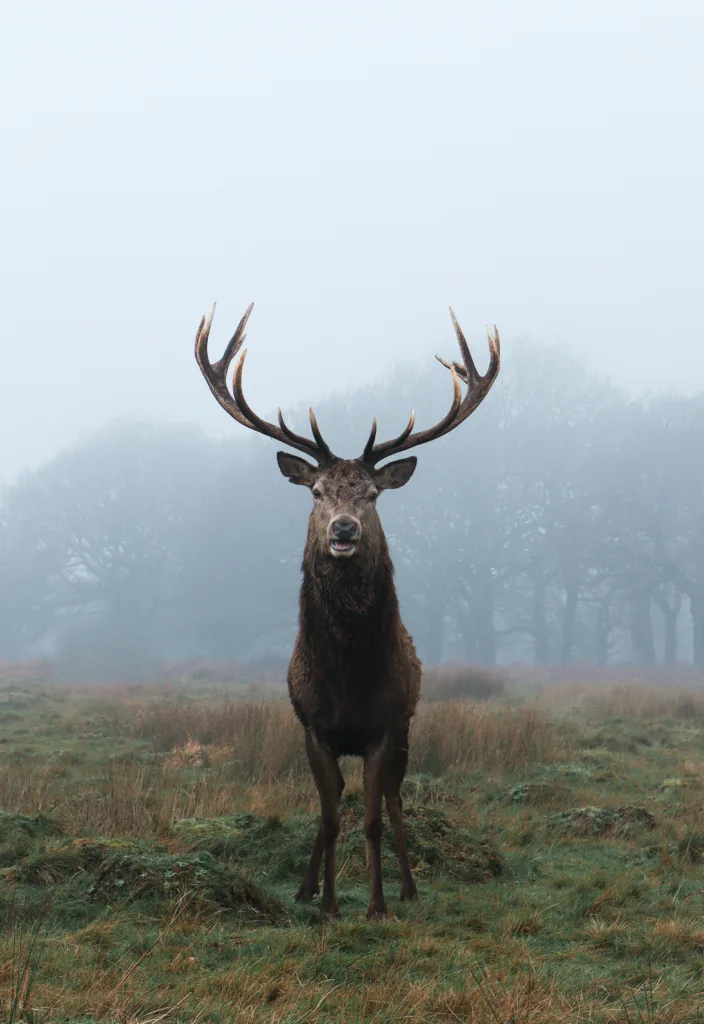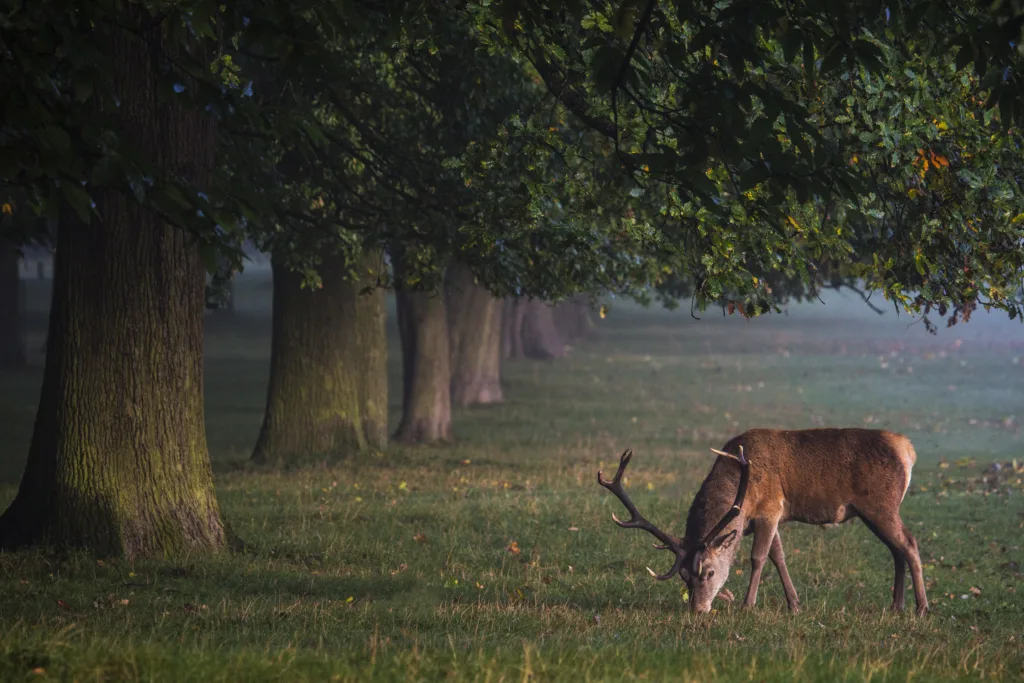Deer are fascinating creatures that have unique behaviors and communication methods. One intriguing behavior that you may observe while in the presence of deer is when they bow their heads. This action can have various meanings and it is important to understand what it may indicate.
Firstly, it is important to note that deer have limited depth perception. This means that they may need to view objects from multiple angles in order to fully comprehend their surroundings. When a deer bows its head, it is often trying to get a better perspective on something that has caught its attention. This behavior allows the deer to gather more information about its environment and assess potential threats or opportunities.
When a deer bows its head, it is not necessarily a sign of aggression or fear. Instead, it is usually a sign of curiosity or attentiveness. The deer is simply trying to gather as much information as possible before making a decision or taking action. So, if you notice a deer bowing its head in your presence, it is generally a good sign that the deer is at ease and not feeling threatened.
Another behavior to look out for when observing deer is their tail movements. A casual, gentle swishing or wagging of the tail is a positive sign. It indicates that the deer is relaxed and comfortable in its environment. This is a good indicator that you can safely observe the deer without causing any distress.
On the other hand, if you notice a deer with a tucked tail, it may indicate fear or anxiety. When deer feel threatened or perceive danger, they often tuck their tails tightly against their rumps. This is a defensive posture that helps protect their vulnerable rear end. Additionally, an aggressive deer may also have its hair standing on end, which further signifies its aggressive stance.
In the case of male deer, or bucks, bowing their heads may also be a display of dominance or aggression. During the mating season, bucks may engage in sparring or antler rushing to establish dominance and attract mates. This behavior involves the bucks facing each other, lowering their heads with their antlers pointing towards each other, and gently pushing or locking antlers. This display of strength and dominance is their way of asserting their position and determining who is the more dominant male.
When a deer bows its head, it is usually a sign of curiosity or attentiveness rather than aggression or fear. They are simply trying to gather more information about their surroundings. However, a tucked tail and hair standing on end may indicate fear or aggression. Understanding these behaviors can help you better interpret and appreciate the fascinating world of deer. So, when you encounter a deer bowing its head, observe their body language and tail movements to gauge their level of comfort and behavior.
What Does It Mean If A Deer Nods Its Head At You?
When a deer nods its head at you, it can have several meanings. Understanding the behavior of deer can help shed light on this action. Deer, like many other animals, have limited depth perception. This means that they may need to look at an object or a person from different angles to get a complete picture. When a deer starts bobbing its head at you, it could be trying to get a better sense of your presence or to gather more information about you.
Here are some possible explanations for why a deer might nod its head at you:
1. Assessing threat: Deer are naturally cautious animals, and they constantly assess their surroundings for potential threats. When a deer nods its head at you, it could be trying to determine if you pose any danger. By moving its head up and down, the deer may be trying to get a better view of you and your movements.
2. Curiosity: Deer are curious creatures, and they may display head-nodding behavior out of curiosity. They might be interested in something about you or your activities that caught their attention. It could be your scent, movement, or even an object you are carrying.
3. Communication: Deer also use head movements as a form of communication with other deer. Nodding their heads can be a way to signal their presence or intentions to other deer in their group. If you encounter a deer that is nodding its head at you, it could be trying to communicate with other deer nearby.
4. Visual confirmation: As mentioned earlier, deer have limited depth perception. By bobbing their heads, they may be trying to get a better visual confirmation of your presence. They may need to see you from different angles to fully comprehend your position and assess any potential threat you may pose.
It is important to note that deer behavior can vary, and there may be other reasons for a deer to nod its head at you. Each encounter with a deer should be treated with caution and respect. It is crucial to observe from a safe distance and avoid any actions that may startle or provoke the animal.

How Do You Tell If A Deer Likes You?
Determining whether a deer likes you can be a bit challenging, as deer are wild animals and typically do not form personal attachments to humans. However, there are certain signs you can look for to gauge a deer’s level of comfort or ease around you. Here are a few indicators that might suggest a deer is at ease:
1. Relaxed body language: When a deer feels comfortable, it tends to exhibit calm and relaxed body language. It may hold its body in a more upright and less tense posture, with its muscles appearing loose and relaxed.
2. Ears pointed forward: A deer that likes its surroundings and feels safe may have its ears pointed forward, showing attentiveness and curiosity. This indicates that it is not perceiving any immediate threat or danger.
3. Occasional tail movements: Casual, gentle, and occasional side-to-side tail wagging or swishing is often a positive sign. These relaxed movements indicate a deer at ease, as opposed to a rapid, stiff, or repeated tail flicking, which could suggest agitation or unease.
4. Lack of sudden movements: If a deer feels comfortable in your presence, it is less likely to make sudden or rapid movements. Instead, it may move slowly and gracefully, indicating a sense of calmness and trust.
5. Continued grazing or browsing: Deer are herbivores, and their primary focus is finding food. If a deer continues to graze or browse in your presence, it can be a good sign that it feels secure and unthreatened by your presence.
It’s important to remember that deer are wild animals, and their behaviors can vary depending on their individual experiences and environmental factors. While these signs may suggest a deer’s comfort, it does not necessarily mean that it likes you in the same way a domesticated animal might. Always maintain a respectful distance and avoid approaching or attempting to interact with wild deer, as they are best appreciated from afar.
What Does It Mean When A Deer Lowers Its Head?
When a deer lowers its head, it signifies a specific behavior or intention. This behavior can be observed in various contexts and may convey different meanings. Here are some possible explanations for why a deer lowers its head:
1. Feeding Behavior: One common reason for a deer to lower its head is when it is grazing or browsing for food. By lowering its head, the deer can get closer to the ground and reach vegetation more easily. This behavior is often seen when deer are peacefully foraging in their natural habitat.
2. Alertness and Caution: Lowering the head can also be a sign of heightened awareness or caution. When a deer senses potential danger or feels threatened, it may lower its head to focus its attention on the surroundings. This posture allows the deer to have a better view of its surroundings and helps it stay vigilant against potential predators.
3. Antler Display: In some situations, a deer may lower its head to display its antlers. Antlers are primarily used for intra-species communication and competition among male deer during the mating season. By lowering its head and pointing its antlers forward, a deer can signal its dominance or readiness to engage in sparring with a rival.
It is important to note that the behavior of deer can vary depending on the species, individual temperament, and the specific circumstances. Additionally, other body language cues, such as ear position, tail movement, and overall body posture, should be considered to better understand the deer’s intentions and emotions.
When a deer lowers its head, it can indicate feeding behavior, alertness, or an intention to display its antlers. Understanding these behaviors can provide insights into the deer’s current state and help in interpreting its actions.
How Do You Know When A Deer Is Mad?
When trying to determine if a deer is mad or angry, there are a few key indicators to look out for:
1. Tucked tail: A mad or aggressive deer will often tuck its tail tightly against its rump. This behavior can also be observed in fearful deer, so it should be considered along with other signs.
2. Hair standing on end: In addition to a tucked tail, an aggressive deer may have its hair standing on end. This is a clear sign of aggression and can often be seen along the back and neck of the deer.
3. Dropping ears: Mad deer will typically have their ears dropped, meaning they are positioned lower than usual. This is a defensive posture and can indicate aggression.
4. Stiff, heavy walk: Another noticeable sign of a mad deer is its walk. Aggressive deer will have a stiff and heavy gait, often accompanied by a slow and deliberate movement. This is in contrast to the more relaxed and fluid movements of a non-aggressive deer.
It’s important to note that these signs should be observed in combination rather than in isolation to accurately assess a deer’s mood. If you encounter a deer displaying these behaviors, it is advisable to keep your distance and avoid any actions that may provoke or escalate the situation.

Conclusion
Understanding deer behavior is crucial for hunters and wildlife enthusiasts alike. By observing their body language and movements, we can gain insight into their intentions and emotions. Head bobbing, for example, is a way for deer to gather more information about their surroundings due to their limited depth perception. On the other hand, relaxed movements such as gentle tail wagging indicate a deer at ease.
When it comes to aggression, certain signs become apparent. A lowered head with antlers pointed directly at a rival signifies the intention to charge. If the opponent responds with a similar antler threat, sparring or an antler rush may follow. Dropping ears and a stiff, heavy walk are clear indicators of aggression in deer.
Additionally, the position of a deer’s tail can provide valuable information. A tightly tucked tail against the rump can signal fear, while an aggressive deer may also have hair that stands on end.
By familiarizing ourselves with these behavioral cues, we can better understand and respect the natural behavior of deer. This knowledge can enhance our experiences in the field and contribute to the conservation and management of these magnificent animals.
